REVIEW PROBLEMS ON QUADRATIC FUNCTIONS AND EQUATIONS
Problem 1 :
Write an equation for the parabola whose vertex is at (3, 6) and which passes through (4, 4).
a. y = -2(x + 3)2 – 6 c. y = 2(x - 3)2 + 6
b. y = (x + 3)2 – 6 d. y = -2(x - 3)2 + 6
Solution :
Vertex = (3, 6)
Passes through the point = (4, 4)
y = a(x – h)2 + k
x = 4, y = 4
h = 3, k = 6
By applying the vertex, we get
y = a(x – 3)2 + 6 --- (1)
By applying the point passes through the parabola, we get
4 = a(4 – 3)2 + 6
4 = a + 6
4 – 6 = a
-2 = a
a = -2 in equation (1)
y = -2(x – 3)2 + 6
So, option (d) is correct.
Problem 2 :
Solve the quadratic equation :
x2 + 10x + 22 = 0
a. 5 ± 2√7 c.100 ± √3
b. -5 ± √3 d.-10 ± 2√7
Solution :
x2 + 10x + 22 = 0
This quadratic equation is not factorable, using formula we can solve it.
a = 1, b = 10, c = 22
x = -b ± √(b2 – 4ac)/2a
= (-10 ± √((10)2 – 4(1)(22)))/2(1)
= (-10 ± √(100 – 88))/2
= -10/2 ± √12/2
= -5 ± √(4 × 3)/2
= -5 ± 2√3/2
= -5 ± √3
So, option (b) is correct.
Problem 3 :
The function y = -16t2 + 248 models the height y in feet of a stone t seconds after it is dropped from the edge of a vertical cliff. How long will it take the stone to hit the ground ? Round to the nearest hundredth of a second.
a. 7.87 seconds c. 3.94 seconds
b. 0.25 seconds d. 5.57 seconds
Solution :
Given, y = -16t2 + 248
When y = 0
0 = -16t2 + 248
248 = 16t2
248/16 = t2
√248/16 = t
√31/2 = t
√15.5 = t
3.94 = t
So, 3.94 seconds long will it take the stone to hit the ground.
So, option (c) is correct.
Problem 4 :
Use a graphing calculator to solve the equation -10x2 – 2x + 3 = 0. If necessary, round to the nearest hundredth.
a. – 0.46, 0.66 c. -0.66, 0.46
b. -1.31, 0.91 d. -0.56, 0.56
Solution :
Given, -10x2 – 2x + 3 = 0
x = -b ± √(b2 – 4ac)/2a
a = -10, b = -2, c = 3
= (2 ± √(22 – 4(-10)(3)))/2(-10)
= (2 ± √(4 + 120))/(-20)
= (2 ± √124)/(-20)
= (2 ± √(31 × 4))/(-20)
= (2 ± 2√31)/(-20)
= 2/(-20) ± 2√31/(-20)
= (-1 ± √31)/10
x = (-1 + √31)/10, (-1 - √31)/10
= (-1 + 5.568)/10, (-1 – 5.568)/10
= 4.568/10, -6.568/10
= 0.46, -0.66
So, option
(c) is correct.
Problem 5 :
Solve the equation.
36x2 + 4 = 0
a. -1/3i, 1/3i c. -1/9i, 1/9i
b. -1/3, 1/3 d. -3i, 3i
Solution :
36x2 + 4 = 0
36x2 = -4
x2 = -4/36
x2 = -1/9
x = ±√-1/9
x = ±√(-1 × 1/9)
x = ±i√1/9
x = 1/3i, -1/3i
So, option (a) is correct.
Problem 6 :
Which is the graph of y = (x – 2)2 + 4?
a)
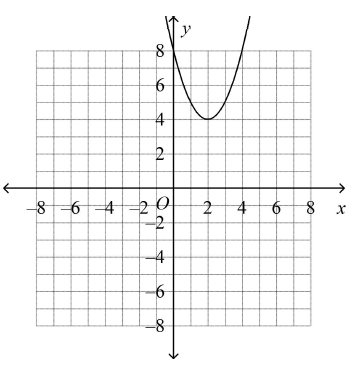
b)
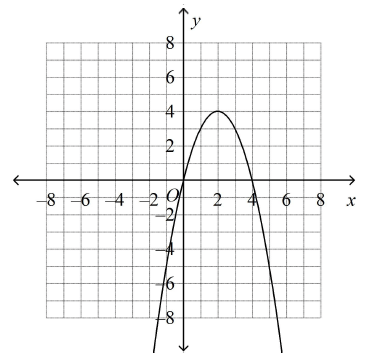
c)
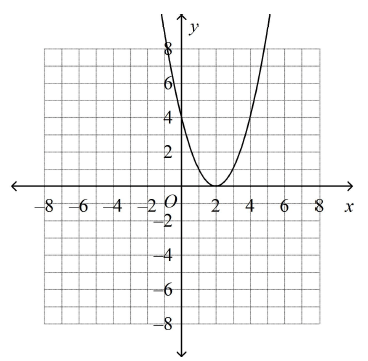
d)
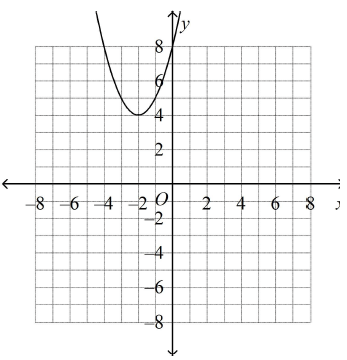
Solution :
y = (x – 2)2 + 4
Comparing the equation given above with y = a(x - h)2 + k
a = 1 > 0. Then parabola opens up. Vertex is at (2, 4).
To find x-intercept, put y = 0
(x – 2)2 + 4 = 0
(x – 2)2 = -4
There is no x-intercept. So, option a is correct.
Problem 7 :
Solve by factoring.
4x2 + 10x – 24 = 0
a. 3/2, -1 c. 4, -1
b. -4, 3/2 d. -4, 4
Solution :
4x2 + 10x – 24 = 0
2(2x2 + 5x – 12) = 0
Dividing 2 on both sides.
2x2 + 5x – 12 = 0
By using algebraic expression
2x2 + 8x – 3x – 12 = 0
2x(x + 4) – 3(x + 4) = 0
(2x – 3) (x + 4) = 0
2x – 3 = 0 and x + 4 = 0
2x = 3
x = 3/2 , x = -4
So, option (b) is correct.
Problem 8 :
Identify the vertex and the y – intercept of the graph of the function y = 2(x + 2)2 – 2.
a. vertex : (2, 2), y – intercept : 8
b. vertex : (-2, -2), y – intercept : 6
c. vertex : (2, -2), y – intercept : 6
d. vertex : (-2, 2), y – intercept : 2
Solution :
y = 2(x + 2)2 – 2
Comparing the given equation with,
y = a(x - h)2 + k
Vertex is at (h, k) ==> (-2, -2).
To find y-intercept, put x = 0
y = 2(0 + 2)2 – 2
y = 2(4) – 2
y = 6
y – intercept = 6
So, option (b) is correct.
Problem 9 :
y = 3x2 – 36x + 111. What is the minimum value of the function ?
Solution :
To get maximum or minimum value of the quadratic function, we have to write it in the vertex form.
y = 3(x2 – 12x) + 111
y = 3(x2 – 2 ⋅ 6 ⋅ x + 62 - 62) + 111
y = 3[(x – 6)2 - 62] + 111
y = 3[(x – 6)2 - 36] + 111
y = 3(x – 6)2 - 108 + 111
y = 3(x – 6)2 + 3
a = 3 > 0, the parabola opens up. So, it will have minimum value.
Vertex is at (6, 3)
So, the minimum value is at y = 3.
Problem 10 :
Use vertex form to write the equation of the parabola.
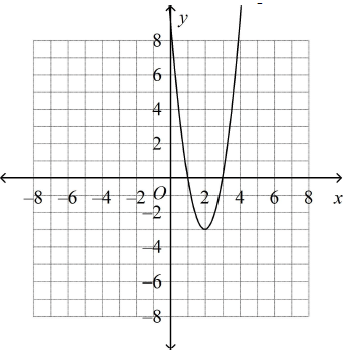
a. y = (x –
2)2 – 3 c. y = 3(x - 2)2 - 3
b. y = 3(x + 2)2 – 3 d. y = 3(x + 2)2 + 3
Solution :
The equation of the parabola y = a(x – h)2 + k
Vertex = (2, -3)
= a(x – 2)2 – 3
Passes through the point (1, 0)
a – 3 = 0
a = 3
a = 3 substitute in equation a(x – 2)2 – 3.
= 3(x – 2)2 – 3
Recent Articles
-
Finding Range of Values Inequality Problems
May 21, 24 08:51 PM
Finding Range of Values Inequality Problems -
Solving Two Step Inequality Word Problems
May 21, 24 08:51 AM
Solving Two Step Inequality Word Problems -
Exponential Function Context and Data Modeling
May 20, 24 10:45 PM
Exponential Function Context and Data Modeling